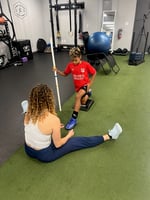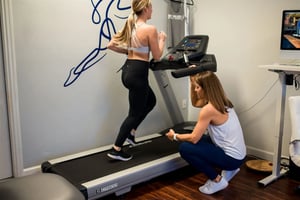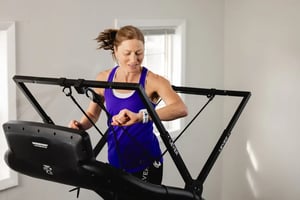Running efficiency isn’t just for elite athletes chasing race-day PRs. Whether you're training for...
The Adaptable Runner: Building Durability Through Targeted PT
Why Resilience Matters for Runners
Running is one of the most popular forms of exercise in the world. It’s accessible, effective, and empowering—until an injury interrupts progress. Whether you're a weekend jogger or a seasoned marathoner, the truth is clear: running places significant demands on the body. And over time, those demands can lead to wear and tear if not properly managed.
Resilience, in the context of running, refers to the body’s ability to absorb stress, recover efficiently, and continue performing without breaking down. It’s not just about how far or fast you can go—it’s about how long you can keep going without injury or setback. Unfortunately, most runners don’t focus on resilience until they’re already sidelined by pain.
That’s where targeted physical therapy makes a profound difference. Instead of chasing symptoms or applying short-term fixes, physical therapy offers a structured approach to injury prevention, performance optimization, and long-term durability. By addressing the root causes of dysfunction and building the body’s tolerance to stress, runners can stay strong, mobile, and consistent—season after season.
At Core Values in Winter Garden, Florida, we specialize in helping runners develop the kind of physical resilience that supports lifelong movement. Through our Resilient Runner Program, we guide athletes toward smarter training, better biomechanics, and a body that’s built to last.

The Most Common Injuries Runners Face — And Why
Running may look simple on the surface, but it’s a repetitive, high-impact activity that puts substantial strain on the muscles, joints, and connective tissues. Over time, that strain can add up—especially when training habits, movement mechanics, or recovery routines are out of balance.
Some of the most common injuries runners encounter include:
- Iliotibial (IT) Band Syndrome: A sharp, lateral knee pain often caused by hip weakness or poor running mechanics.
- Patellofemoral Pain Syndrome (Runner’s Knee): Aching around the kneecap due to alignment issues, muscle imbalances, or overuse.
- Plantar Fasciitis: Stabbing heel pain that develops from tight calves, poor foot mechanics, or insufficient arch support.
- Achilles Tendinopathy: Stiffness and pain in the back of the ankle, often linked to sudden increases in mileage or improper footwear.
- Stress Fractures: Micro-cracks in bones—commonly in the shin or foot—caused by repetitive impact and inadequate recovery.
What many runners don’t realize is that these injuries are often symptoms, not the root problem. Factors like limited ankle mobility, poor core stability, and underactive glutes contribute to faulty running mechanics that, over time, lead to breakdowns. Add in training errors—like ramping up distance too quickly or ignoring pain signals—and it becomes a recipe for chronic issues.
This is exactly where physical therapy shines. Instead of just treating the painful area, physical therapists at Core Values dig deeper to uncover why the pain started in the first place. By addressing underlying dysfunctions, we help runners move more efficiently, load tissues properly, and reduce the likelihood of injury reoccurrence.
The Foundation of Resilience: Biomechanics and Running Form
Resilient runners aren’t just strong—they move well. Efficient biomechanics form the backbone of injury prevention and sustainable performance. When your body moves in alignment, each step distributes force evenly, muscles activate in the right sequence, and joints operate through their full, intended range. But when even small inefficiencies creep in, the body compensates—and compensation leads to strain.
Most runners aren’t aware of their own movement patterns until something hurts. That’s why at Core Values, we take a proactive approach. Through detailed biomechanical assessments, we analyze everything from joint mobility and muscle engagement to running gait and posture. We look at how the body behaves in motion, not just at rest.
A few of the most common dysfunctions we identify include:
- Hip drop due to weak gluteal muscles
- Excessive pronation or collapsing arches during foot strike
- Overstriding, where the foot lands too far in front of the body
- Limited thoracic rotation, which can restrict arm swing and rhythm

These movement faults might not cause immediate pain, but over time, they create inefficiencies that sap performance and increase injury risk. The good news is that movement can be retrained. Physical therapists use targeted exercises, cueing strategies, and hands-on techniques to restore proper movement mechanics and rebuild durability from the ground up.
When form is aligned and efficient, runners don’t just avoid injury—they become more powerful, more economical, and more confident on every run.
How Targeted Physical Therapy Builds Long-Term Durability
Durability isn’t built by chance—it’s built by design. While rest may temporarily relieve symptoms, true resilience in running comes from addressing the deeper causes of dysfunction and preparing the body to handle stress. This is where targeted physical therapy sets itself apart from generic recovery advice or passive treatment methods.
At Core Values, physical therapy is a proactive strategy. Our approach blends movement analysis, strength development, and neuromuscular training to build a body that doesn’t just survive miles—it thrives through them.
Key components of our approach include:
- Strength Training: Focused activation of the posterior chain, hip stabilizers, and core to support proper mechanics and absorb impact.
- Mobility Work: Improving joint range of motion—especially in the ankles, hips, and thoracic spine—so the body moves efficiently and without restriction.
- Gait Retraining: Using visual feedback, cadence adjustments, and cueing to optimize stride mechanics and reduce repetitive stress.
- Neuromuscular Re-education: Teaching the brain and muscles to work together in better patterns through drills and corrective exercises.
Rather than offering a one-size-fits-all plan, we tailor each program to the runner’s unique needs. This includes looking at their injury history, training goals, and movement profile. Every aspect of care is aligned to help runners build a more resilient foundation—not just to return to running, but to stay running strong for the long haul.
The Resilient Runner Program at Core Values
At Core Values, we’ve created a specialized approach for runners who want to stay healthy, run smarter, and perform better—whether they’re chasing a new PR or simply trying to run pain-free. The Resilient Runner Program is built on the belief that every athlete deserves personalized care that not only resolves pain but also builds long-term durability.
This program goes beyond traditional rehab. It’s designed for runners at any stage—whether you're currently injured, feeling recurring aches, or looking to prevent setbacks before they begin. The process starts with a comprehensive assessment that includes:
- Movement Screening: Identifying muscle imbalances, joint restrictions, and faulty movement patterns.
- Gait Analysis: Reviewing your running form to highlight inefficiencies or technique issues.
- Strength & Mobility Testing: Measuring the body’s readiness to absorb load and perform consistently.
- Goal Setting: Aligning care with each runner’s personal goals, whether that's distance, speed, or simply consistency.
From there, runners are guided through a customized plan that may include manual therapy, strength programming, neuromuscular retraining, and sport-specific conditioning. Every visit builds on the last, progressing the runner through stages of recovery, performance, and resilience.
What sets Core Values apart is our integrated, education-driven model. We don’t just treat—we teach. Runners gain a deeper understanding of their own biomechanics, what’s contributing to their pain or inefficiency, and how to maintain progress over time.
Whether you’re recovering from an injury or preparing for your next big race, the Resilient Runner Program is your blueprint for running smarter, longer, and stronger.
Success Stories: From Injury-Prone to Injury-Free
One of the most powerful ways to understand the impact of targeted physical therapy is through the experiences of runners who’ve lived it. At Core Values, we’ve helped countless athletes transition from frustration and frequent injuries to confidence and consistency on the road.
Take Emily, a half-marathoner from Winter Garden who came to us after battling persistent shin splints. She had tried everything—ice, rest, new shoes—but the pain always returned. Through our Resilient Runner Program, we discovered that limited ankle mobility and weak glutes were contributing to her recurring stress. After just a few weeks of focused mobility work, gait retraining, and progressive strength programming, Emily not only returned to pain-free running but hit a new personal best six months later.
Or consider Marcus, a recreational runner and father of two, who struggled with nagging knee pain anytime he increased his mileage. A full biomechanical screen revealed asymmetrical loading in his hips and a history of unresolved ankle sprains. With targeted neuromuscular re-education and joint mobilization, Marcus built better balance and control in his stride. Today, he’s training for his first marathon—without pain.
These stories are more than just recovery—they’re proof that with the right support, runners can evolve. They can become more aware of their body, more efficient in their movement, and more empowered in their training.
At Core Values, we don’t just treat injuries—we help runners build a stronger foundation for the miles ahead.

Physical Therapy vs. “Just Resting”: Why Movement is Medicine
It’s a common instinct for runners to stop everything when pain arises. Rest feels like the safest option—avoiding further damage and allowing time to heal. But while rest can be helpful in the immediate aftermath of an injury, it’s rarely the full solution. In fact, prolonged inactivity can often delay recovery and lead to further imbalances.
At Core Values, we help runners understand a more effective path forward: guided, intentional movement. When tailored correctly, movement doesn’t aggravate injury—it promotes healing. Through progressive loading, neuromuscular activation, and specific mobility work, physical therapy helps tissues adapt, grow stronger, and regain their functional capacity.
Resting without addressing the root cause of an issue may offer temporary relief, but it doesn’t resolve the problem. Without intervention, the same mechanics that led to pain in the first place will likely lead right back to it.
Here’s what movement-based recovery looks like in practice:
- A runner with Achilles pain begins eccentric calf loading to stimulate tendon healing.
- A patient with knee discomfort uses closed-chain exercises to improve hip control and reduce joint stress.
- A sprinter recovering from a hamstring strain follows a graded return-to-run progression that rebuilds capacity and confidence.
Movement is medicine—but only when it’s applied strategically. That’s the difference physical therapy makes. It transforms rest into active recovery and pain into progress.
Building a Stronger Runner Community in Winter Garden
At Core Values, we believe that health isn’t just personal—it’s communal. That’s why our commitment to runner resilience extends beyond the treatment room and into the streets of Winter Garden. Through initiatives like the Orlando Run Club, we’ve built a local community where runners of all levels can connect, train, and grow together.
Community matters in running. It offers accountability, support, and the motivation to stay consistent—even when schedules get busy or progress feels slow. Whether you're recovering from an injury or setting a new goal, surrounding yourself with others who understand the journey can make all the difference.
The Orlando Run Club is more than a meet-up—it’s an extension of our clinical mission. Many of our physical therapists attend events, lead warmups, and provide on-site advice for runners. We answer questions, demonstrate mobility drills, and educate participants on injury prevention techniques in real time.
This integration of clinic and community creates a unique environment where education meets action. Runners leave not only with a workout but with tools they can immediately apply to their own training.
By fostering a culture of movement, knowledge, and connection, Core Values is helping build more than just strong runners—we’re helping build a resilient running community in Winter Garden.
FAQs About Running and Physical Therapy
When it comes to physical therapy, runners often have questions about when to seek help, what to expect, and how it fits into their training. Here are some of the most common questions we hear at Core Values—along with clear, honest answers.
Do I need to be injured to see a physical therapist?
Not at all. In fact, many of the runners we work with are injury-free and looking to stay that way. Physical therapy is just as effective as a preventive tool as it is for rehab. Assessing your biomechanics, strength, and mobility before pain shows up can save time, frustration, and lost training down the road.
How long does it take to see improvement?
That depends on the individual and their goals. Some runners notice improvements in pain and movement within the first few sessions. Others with more complex issues may need several weeks of consistent care. What’s consistent across the board is that our programs are designed to deliver steady, measurable progress with each visit.
Can physical therapy help me run faster or farther?
Yes—when your body moves more efficiently, you use less energy and recover more quickly. Physical therapy improves strength, coordination, and joint function, all of which contribute to better running economy. That means improved endurance, more consistent pacing, and fewer breakdowns over time.
Will I have to stop running during treatment?
Not necessarily. At Core Values, we don’t believe in taking running away—we believe in modifying it to support healing. We’ll help you adjust volume, intensity, or terrain while addressing the root cause of your issue so you can keep moving safely.
What makes physical therapy different from other fitness programs?
Physical therapy is medically informed, evidence-based, and tailored to your specific needs. We’re not just here to make you sweat—we’re here to help your body work the way it’s designed to, with the guidance of licensed professionals who understand both the demands of running and the science of recovery.
Getting Started: Book a Consultation with a Physical Therapist
Whether you're managing a nagging injury, preparing for your next race, or simply want to feel stronger and more confident in your stride, the best time to take action is now. The Resilient Runner Program at Core Values is built to meet you where you are and help you reach your next level—pain-free, informed, and empowered.
Our team of licensed physical therapists in Winter Garden specializes in working with runners of all experience levels. We combine deep clinical expertise with a passion for movement, tailoring every plan to your body, goals, and lifestyle.
Here’s how to get started:
- Schedule a one-on-one consultation
We’ll dive into your movement patterns, training history, and current concerns to build a foundation for care. - Get a personalized plan
Your treatment and training roadmap will include strength work, mobility, gait analysis, and more—all designed to support your unique needs as a runner. - Run smarter, longer, and stronger
With ongoing support from your PT and access to a like-minded running community, you’ll be set up for success both now and long-term.
Ready to take the next step? Learn more about the Resilient Runner Program or book a consultation today.



